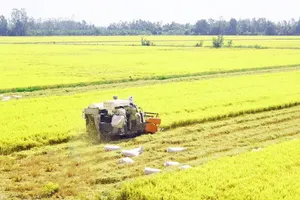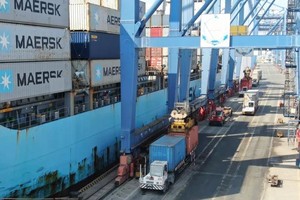 |
The lotus cultivation combined with fish farming model of farmers in Hau Giang. (Photo: SGGP) |
In March 2023, during the peak of the dry season, saltwater intrusion extended up to 40-50km into the estuaries. Despite this, many farmers have become accustomed to such occurrences and taken proactive measures, such as implementing production models, to maintain their livelihoods during the drought season and mitigate the effects of saltwater intrusion.
Storing fresh water, avoiding saltwater
Over two decades ago, farmers in the Mekong Delta had to plant early summer-autumn rice crops to evade flooding from the Mekong in August. Similarly, people in the Mekong Delta now stockpile fresh water and actively avoid local saline intrusion during the dry season. In the final days of March 2023, fruit growers in provinces like Vinh Long, Tien Giang, Hau Giang, and Soc Trang have prepared to tackle saltwater intrusion caused by high tides. Every fruit grower recognizes that monitoring salinity levels and digging ditches to store fresh water for irrigation purposes are essential measures to sustain their livelihoods.
In Tam Binh Commune, Cai Lay District, Tien Giang Province, Nguyen Thi Hue's family has taken meticulous steps to safeguard their orchard. They have carefully dredged ditches and rebuilt dams to accumulate fresh water when needed, as saltwater intrusion poses a risk to their 5,000 square meter durian plantation, which is their primary source of income. Besides storing fresh water, the family keeps the grass around the trees to keep the durian trees moist during the prevailing hot weather. They also use plastic films to cover the dams in their orchard to prevent the loss of fresh water.
Given durians’ susceptibility to saltwater, farmers must exercise great care in cultivating this fruit. Ngu Hiep Islet, situated in the Tien River in Cai Lay District, Tien Giang Province, is home to nearly 100 percent of the agricultural land dedicated to specialized durian farming. However, this locality faces the threat of saltwater from not just the Tien River but also the Ham Luong and Co Chien rivers in Ben Tre Province.
To combat this issue, Mr. Nguyen Tan Nhu, Secretary of the Party Committee of Ngu Hiep Commune, Cai Lay District, reported that the commune had taken proactive measures such as storing water with sluices, dams, and eight backup wells. If saltwater intrusion occurs, the sluices will be closed, and the wells will be used to pump water into the canals for irrigation purposes. Additionally, the commune has two unclosed culverts. If they are affected by saltwater, the district will provide financial support to have them closed.
In Vinh Long Province, a CMS notification system alerts hamlets when rivers are encroached by saltwater with a salinity level of 4 per mille, and the closed dike system is activated to prevent local saltwater intrusion. Like Ngu Hiep Islet in Tien Giang Province, the livelihoods of people in Thanh Binh Island Commune on the Co Chien River in Vung Liem District, Vinh Long Province, depend heavily on durian trees. Many farmers here report earning from several tens of millions of Vietnamese dong to several hundred million Vietnamese dong for every 1,000 square meters of durian.
Mr. Pham Van Tieu, the Head of the Durian Cooperation Group in Lang Hamlet, Thanh Binh Commune, Vung Liem District, Vinh Long Province, recently sold durian for VND45 million. According to Mr. Tieu, he updates the information regularly, particularly before watering the orchard.
Fruit growers in the Thanh Binh Island cooperative group use salinity meters to measure the salinity of the water before watering or spraying the flowers and fruits, thus preventing any damage to the crops. The cooperative group consists of 44 households with 250,000 square meters of durian orchards, yielding an average of 2 tons per 1,000 square meters.
Farmers no longer worry about saltwater intrusion as there is a system in place to store fresh water in orchard ditches, and warning information is updated regularly day and night. Moreover, the province and the district have constructed sluice gates and dams to prevent saltwater intrusion, which have proven to be effective for many years.
 |
Building a dam to prevent saltwater intrusion and store fresh water on Nguyen Tan Thanh Canal, Chau Thanh District, Tien Giang Province. (Photo: SGGP) |
The Department of Agriculture and Rural Development of Vung Liem District in Vinh Long Province reports that due to the implementation of a closed dike system and the increased awareness of fruit growers in protecting their orchards, the district has been able to ensure a fresh water supply for irrigation and daily life of local people in recent years. Despite the salinity level in the area reaching about 5 per mille, the orchards have not been damaged so far.
Growing vegetables on rice fields
The Mekong Delta has been plagued by historic droughts and saltwater intrusions in 2016 and 2020, causing immense obsession for thousands of rice farmers. During these periods, many fields were covered in dead, yellow leaves, the soil cracked and became white, and canals dried up.
Do Quang Thao, a 40-year-old farmer from Long Duc Commune in Long Phu district, Soc Trang province, shared his experience: "During that time, our rice had bloomed and was in the process of developing seeds when the saltwater intrusion occurred. As a result, my family was left with nothing and burdened with debt."
The Head of the Department of Agriculture and Rural Development of Long Phu District, Soc Trang Province, Mr. Lam Van Vu, has noted that despite warnings from the agricultural sector against sowing a third rice crop, farmers continued to do so out of habit.
However, following the bitter consequences of droughts in 2016 and 2020, farmers have become more aware of the risks involved. As a result, the third rice crop area in the district has decreased significantly from over 16,000 hectares to only a few households using traditional sowing methods.
This shift in awareness has led to the emergence of various production models adapted to climate change, such as replacing ineffective rice cultivation with vegetable farming. This approach has resulted in economic profits many times higher than that of rice cultivation in the third crop.
Sai Gon Giai Phong Newspaper's reporters returned to Chau Khanh Commune, Long Phu District, Soc Trang Province, in the scorching heat and dry weather of the last days of March. In front of them were lush green cucumber fields full of fruit.
Huynh Thanh Can, a local cucumber farmer, said that instead of sowing the third rice crop or leaving the land idle as before, he had switched to growing cucumbers during his leisure time. Taking advantage of the time when salinity had not yet risen, he stored fresh water in ditches and, at the same time, applied an economical irrigation method, so he could feel assured when farming.
Although it requires more effort than growing rice, cucumbers give 7-8 times higher income. With 2,000 square meters of cucumbers, if the yield is achieved, he can harvest 800-900kg of cucumbers daily. If the price of cucumbers is VND10,000 per kg, he can earn VND8-9 million a day. Thus, each cucumber crop will give an income of over VND140 million. Excluding expenses, there will be a profit of a few dozen to a hundred million Vietnamese dong.
The Department of Agriculture and Rural Development in Long Phu District reports that more than 150 hectares of vegetables have been grown on rice fields to replace rice in the third crop. The model of growing vegetables on rice fields continues to receive active support from the locals, who are expanding the cultivation area with various plants such as cucumber, corn, and squash. It helps farmers adapt to the production conditions in the dry season and brings high economic efficiency.
Seven years ago, an independent research expert on the ecology of the Mekong Delta, MSc Nguyen Huu Thien, along with many other scientists, held an urgent meeting to warn about the historic drought in the Mekong Delta.
Looking back at the implementation of Resolution 120/NQ-CP, Mr. Nguyen Huu Thien shared that there are two ways to adapt to climate change: resolutely resisting change and changing oneself to conform to the new situation.
Resolution 120/NQ-CP has chosen the latter, which is smarter and contains some major principles, including respecting the laws of nature and avoiding violent interference with nature, changing the thinking around agricultural farming, and shifting towards a more sustainable agricultural economy. Both the government and farmers have been adapting to this approach.
























